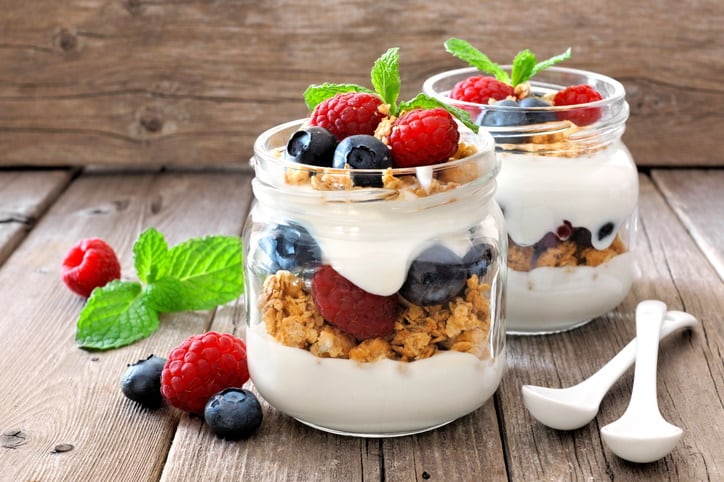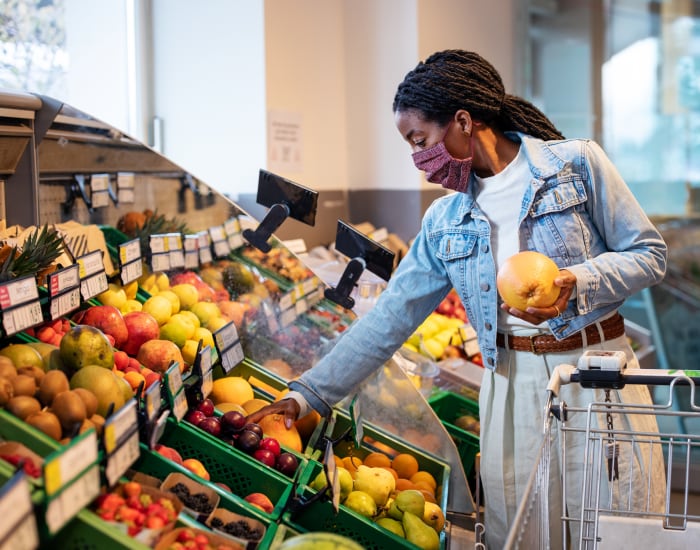Demand for functional foods that deliver digestive health isn’t a new trend – but it is one that looks set to stick around and potentially accelerate.
According to consumer research conducted by Kerry Taste and Nutrition, global shoppers rank digestive health as third on their list of reasons to purchase ‘healthy lifestyle products’, up from fourth position in 2019.
One in four consumers reported eating a product containing probiotics in the past six months, up from 21% in 2019, and 44% said they would consider doing so versus 40% in 2019.
John Quilter, Kerry VP of Global Portfolio for ProActive Health, said a range of factors are supporting this continuing trend. “Demographic changes such as population aging and lifestyle choices have increased the prevalence of digestive disorders, while the pandemic has accelerated the shift towards more proactive approaches to health. As a result, consumers want to see functional ingredients in their favourite food and beverage products,” he observed.
Thinking beyond the gut
Euromonitor estimates that around one-quarter of us suffer from digestive health issues, roughly tallying with the number of global customers Kerry suggests already buy into the probiotic segment. However, the potential health benefits of gut-boosting food and beverages reach well beyond our tummies – a factor that could help drive incremental growth for these wellness products.
“People today are much more concerned with their overall well-being – which is why interest in digestive health is growing so quickly. Gut health has such a large and varied impact on the body and mind that it is often seen as a gateway to more complete well-being,” Linda Peek, Senior Marketing Manager of the Biotis ingredient at FrieslandCampina Ingredients, observed.

Peek suggested that one important selling point could be the positive impact digestive health can have on mental health via the gut-brain axis.
“It’s important for manufacturers to understand why consumers want to better look after their gut. Good gut health can influence brain health, reducing stress levels and supporting better sleep. This gut-brain axis is a key consumer driver,” she told FoodNavigator.
“Last year, 42% of consumers reported a desire to improve their mental well-being [research by FMCG Gurus revealed] and 50% said suffering with stress led to bad moods and issues sleeping [the Innova Consumer Lifestyle and Wellness Survey 2020 showed]. In this era of holistic health, it makes sense that there’s less focus on ‘digestive’ health, and more on ‘gut health’ and the gut-brain axis, as improved digestion is just one of the many benefits of a healthy gut.”
June Lin, Global Vice President of Marketing of Health & Wellness at ADM, agrees that a broader understanding of how a healthy gut supports wider definitions of wellness is resulting in increased interest in the sector. This, she noted, is a trend that has been accelerated by the global COVID-19 pandemic.

“Consumers in both the US and UK are linking microbiome-supporting solutions like probiotics to a wide range of benefits, with gut health the most prominent and overall well-being following closely behind,” she said, citing an ADM/Buzzback report, Microbiome Consumer Exploratory.
“Many [consumers] are becoming aware of the gut microbiome and its link to holistic wellness support. This is paving the way for new ingredient solutions and applications as consumers proactively seek out healthier options, especially in response to the ongoing global pandemic. Due to COVID-19, 61% of global consumers state that they are more conscious of needing to lead a healthy lifestyle, and 44% of global consumers sought out fortified and functional foods and beverages during the month of March 2021 [according to FMCG Gurus].”
Diversifying digestive health: New ingredients and formats
As the appeal of gut friendly food broadens thanks to this more holistic understanding of additional health associations, what ingredients and product formats are resonating most?
FrieslandCampina Ingredients’ Peek suggested that consumers are increasingly open to a broader variety of gut-healthy ingredients beyond the category mainstay – probiotics.
“The opportunities for food and beverage manufacturers – from functional foods to traditional dietary supplements – are incredibly varied. Previously, probiotics dominated the gut health market. While they are still popular with consumers, prebiotics and synbiotics, are also taking their share of the limelight. As consumers become more aware of the varied impact different pre-, post- and pro-biotics have, combined with a move towards holistic wellness, we expect demand for combined solutions that offer more than one benefit to increase.”

The types of product people want to see gut healthy ingredients in is also expanding beyond traditional formats like yogurts or fermented foods.
“People are used to choosing yogurts with a digestive health benefit and many people seek out fermented foods like sourdough, kimchi and cultured dairy products to improve their digestive health. The influx in people looking for ways to incorporate more ‘gut friendly’ food and drinks into their diets is driving innovation in functional food and beverages,” observed Peek.
ADM’s Outside Voice insight, which leverages data gathered from consumer conversations, found beverages are the ‘most discussed’ format, with on-the-go drinks and snacks poised for growth.

Lin identified additional categories that are benefitting from innovation in gut health. “Digestive solutions have moved into mainstream food categories as more consumers seek out functional offerings that they enjoy and fit into their meal and snack habits. For instance, we are seeing new product development emerging in the marketplace with microbiome-supporting solutions incorporated into beverages, jellies, chocolate, bakery items, snacks, bars and more. This need for more digestive health solutions in commonly consumed foods puts added value on ingredients that can survive harsh processing conditions while still retaining their inherent nutritional benefits.”
Ingredients development is supporting expansion into these new areas, she continued. “Applications that already have a gut health halo around them like yogurt and fermented dairy beverages are most suited to digestive health support claims, as they are familiar to consumers. However, with cutting-edge ingredient innovations… brands can now go beyond these traditional formats and incorporate functional ingredients into a variety of offerings for which suitable ingredients may not have been available before.”
Bridging the ‘fibre gap’
An important innovation opportunity also lies in addressing what many consumers identify as a problem with their diets – not eating enough fibre.
Data from Tate & Lyle suggests that 75% of global consumers report not eating enough fibre on a daily basis. Of these, 22% said this was because there are not enough products out there that contain sufficient fibre. Meanwhile 31% of European consumers say they plan to consume more fibre in the next 12 months.
“This is where fibre fortification can play a vital role. It can enable manufacturers to increase the fibre content of different products without losing the taste and texture qualities that consumers love,” said Saquib Ramday, Head of Category Development, Europe, at Tate & Lyle.
“As an example, wholegrains, such as those found in wholemeal bread, are a good natural source of fibre, but we also know that some consumers – particularly children – may prefer white bread. At Tate & Lyle we have worked with our customers to fortify white loaves with up to 12% fibre by using soluble fibres in tandem with our range of stabilisers and functional systems,” he told us.
“This is also true of dairy, and, in particular, has become a prominent claim in dairy alternatives –almost one-third (29%) of dairy alternative drinks launched in Europe between 2015 and 2019 contained some form of on-pack claim about fibre content. Manufacturers must find a balance between increasing fibre content using plant-based sources without negatively impacting on taste or texture.”

Indeed, Ramday suggested taste is the biggest challenge facing food formulators who want to work with gut-healthy ingredients. “We know that taste remains the number one purchase motivator for most global consumers, so it is important to ensure that fortifying products with fibre or other ingredients to improve gut health does not adversely impact on the taste of the end product.”
He also noted any addition to the ingredient list must meet with another important trend that is also driven by health concerns – the demand for clean labels. “The growing focus on gut health chimes in with the wider focus on wellness and other trends within this, including the notable shift towards products that are considered clean-label. Consumers are increasingly paying attention to the ingredients that are being used in their favourite products, which can make ‘adding’ new ingredients to a recipe challenging.”
ADM’s Lin agreed that this can be an issue for F&B innovators. “Nutrient-dense foods and beverages can pose challenges in optimizing flavour and texture profiles. To solve this, we approach each new formulation holistically, keeping both the consumer sensory experience and targeted wellness benefits in mind,” she explained, adding that it’s important that ‘high-quality ingredients’ that are ‘backed by science’ are leveraged.
Food makers are overcoming formulation challenges, increasing availability and access, at the same time as consumer awareness is rising. This means that we can expect a long runway of growth for gut healthy products, Ramday suggested.
“As awareness and education continue to increase, the consumer focus on a healthy gut is likely to continue growing. It is important for manufacturers and producers to make sure they are at the forefront of innovation if they want to take advantage of the opportunities this will present.”




